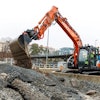AUSTIN - Texas Gov. Rick Perry never misses an opportunity to tweak California.
Its massive budget deficit, often dysfunctional state government and high unemployment make the Golden State an easy target for Perry's jabs.
Still, there is more in common between the Lone Star State and its rival to the west than either probably would like to admit. Among them, both states have seen their populations explode in the past 30 years and each state's transportation infrastructure has struggled to keep up with that growth.
During the next 20 years, the problem is only going to get worse. California expects its population to grow by more than 12 million; Texas by about 10 million.
"It's been a session-by-session, get-through-the-session approach," said state Sen. Kirk Watson, D-Austin, vice-chairman of the Senate Transportation and Homeland Security Committee. "You've never seen a plan for how we're going to build the infrastructure over the long haul to meet the growing population."
According to a study commissioned by the Texas Transportation Commission, during the next 20 years, more than $300 billion in 2009 dollars needs to be invested in Texas roads and freeways just to keep commute times from worsening.
Adjust that figure for expected inflation and the cost balloons to $488 billion. The gasoline tax, which provides most of the funding for road construction and maintenance, is only expected to provide $160 billion in revenue during the same period.
California's plan
California, long maligned as the golden state of governmental malaise, has embarked on a different path. In 2008, California voters approved $10 billion in bonds as a down payment on a $40 billion high-speed rail system that will link San Diego to Los Angeles and Los Angeles to San Francisco and Sacramento via the Central Valley.
Regional transportation authorities have committed about $20 billion to dramatically expand mass transit systems in the San Francisco Bay Area and Los Angeles, as well as an additional $27 billion to pay for operating the transit systems and improving road maintenance.
All told, California's state government and major urban areas will spend more than $80 billion in the next 20 years to transform and expand its transportation infrastructure in a bid to handle the new demand.
"We're going to be much more urbanized in the next 30-50 years, and we're going to need the infrastructure to do it," said California state Sen. Mark DeSaulnier, D-Walnut Creek, who chairs the California State Senate's transportation committee. "And high-speed rail, just like in Japan and Europe, will be the spine of that system."
Still, it has not been easy for the Golden State as it goes about building one of the largest public works projects in recent history.
Members of the California Assembly and the Senate have been highly critical of the lack of oversight of the rail authority, while others have complained projected ridership figures were too optimistic.
The plan also has run into some of the same problems as the Trans-Texas Corridor - opposition from farmers concerned about how train routes will affect their land.
Eight different visions
U.S. Rep. Jim Costa, D-Fresno, who supports high-speed rail, said Europe could offer a model for how best to mitigate the potential damage to farmlands.
"It's a real game changer when you can get from Fresno to San Francisco in 55 minutes," Costa said. "The long-term impacts of greater diversity of the economy here in the Valley by connecting the Valley to the two major economic centers in California" make the system worth building.
When it comes to developing a strategy for rail in Texas, Bill Glavin, the director of the newly formed Rail Division at Texas Department of Transportation acknowledges that the state has been behind.
He said that the bruising battle over high-speed rail in Texas during the late '80s and early '90s contributed to the state's reluctance to actively develop passenger rail during the past 20 years.
When the Obama administration awarded $8 billion to work on developing high-speed passenger rail in December 2009, only about $11 million was given to Texas, even though it is the second most populous state in the country.
Glavin recounted what Karen Rae, a U.S. Department of Transportation official said about Texas' award at a transportation conference that next month: "'There are eight states with one vision in the upper Midwest, they got $1.25 billion to pursue that vision. There was one state with eight visions; they got $11 million to pursue those eight visions.' In reality, she was being very generous. We probably had eight times eight times eight visions."
Possible routes in Texas
The Rail Division recently completed work on Texas' Rail Plan, needed to qualify for federal dollars to help speed development of passenger and freight rail projects.
The plan, approved by the Texas Transportation Commission last November, calls for Texas to begin studying possible routes for a high-speed rail system, including Houston to Austin along U.S. 290, Dallas to Houston along Interstate 45, and Oklahoma City to South Texas. The latter probably would parallel I-35 from Oklahoma City to San Antonio.
"When you look at it, Texas has three of the top 10 metropolitan areas in this nation," Gavin said. "They're all within 300 miles of each other, which puts them right in the wheelhouse for high-speed rail."















